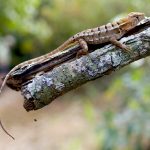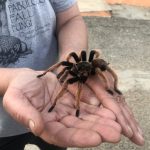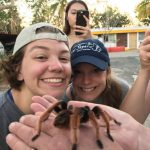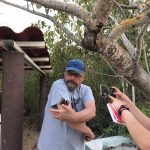What’s that in the forest making those booming noises? Is it an owl? Is it a hawk? No – it’s the Boom Chachalacas coming back at you for blog entry round two! No wait … there are also owls. We awoke this morning to the sounds of two singing owls roosting right outside our windows! As it was the first morning at the Chamela research station, no one had settled into their routines yet. We were all pretty much zombies from the day of travel before. After the cobwebs were shaken off with some strong coffee and the staple meal of cheese quesadillas and beans, we were all ready to start our day.
We began with a hike along some of the local trails, beginning with the main road, Eje Central, and then down Buho to the arroyo to which it leads. Along the way we were introduced to an interesting insect known as the antlion, which creates a pit-like trap in the substrate of the forest floor and waits at the bottom for unlucky visitors. This pit is reminiscent of the Sarlacc pit from Star Wars (minus the tentacles). As we were walking through the forest, we finally understood why Steve and Javier had been cautious about the conditions of the foliage. Hurricane Patricia, which made landfall in October of 2015, left lasting effects on the flora and fauna of the region. Such damage left some areas almost impassable and entry into the forest rather difficult. On our hike we came across an arroyo, or at least what is usually an arroyo during the wet season. It is currently the dry season and as such we saw no water, just the skeleton of where the arroyo usually runs. Within this area we found considerable biodiversity: birds (e.g. San Blas Jay), multiple butterfly (e.g. Interrupted Longtail) and lizard species, and a female scorpion (unknown species) carrying her offspring on her back. We also found an interesting branch with external sap droplets, on which a local bee was feeding. Over the course of the hike, we listened to a few students teach us about the species in this area. We heard about the Black Vulture (Coragyps atratus) from Sean, the Magnificent Frigatebirds (Fregata magnificens) from Chenxi, and the White-nosed Coati (Nausa narica) from Sydney.
When we finally made it back to the station, we all rushed to the air-conditioned library to brainstorm some ideas for group projects that we might be able to conduct in Chamela. You’ll be pleased to hear that the Boom Chachalacas have rebounded from the moisture meter tragedies of Las Joyas and found new inspiration in an unlikely place. We are now looking into the patterns of termite activity with respect to tree habitat and how this may have changed along with the intense ecological shift due to the hurricane. After a delicious lunch consisting of do-it-yourself soft tacos, it was decided a group siesta was necessary before we ventured back out into the wilderness to pilot our new studies.
Following this much needed rest, we set off to get some preliminary data and, to our surprise, this time we had a working study and a pattern that seemed to be interesting! While out in the wilderness collecting this data, Steve caught a Mexican Pink Tarantula (Brachypelma klaasi) back at the station and decided to have a photoshoot. Some brave souls (Darcey and Evelyn) also decided to give it a cuddle, whereas others (Claire) could not have been more delighted to have missed the whole event. Regardless, we got some impressive photos of the rarest species of the Brachypelmagenus! When the groups were all exhausted and ready for dinner, we were greeted with some amazing Mexican burgers. After this, Liam gave a fun and enlighteneing seminar on the topic of coevolution and how it helps to shape the biodiversity we see.
That’s all for the Boom Chachalacas, signing off again, this time with a working project and full bellies.
En Español
Que son esos sonidos estruendosos en el bosque? Es un Buho? Un Halcón?. No somos las Chachalacas ruidosas regresando para contarte todo en esta segunda ronda del blog. OH! Espera, también hay tecolotes. Despertamos esta mañana con el canto de dos tecolotes justo afuera de nuestros dormitorios. Siendo la primera mañana en Chamela, nadie tenía aún su rutuna definida. Todos andábamos como zombies del día de viaje anterior. Después de sacudirnos las telarañas con un café fuerte y un desayuno de quesadillas y frijoles, estábamos listos para iniciar nuestro día.
Comenzamos con una caminata en el sendero principal “Eje Central” del cual después seguimos por otro llamado Buho por el cual caminamos hasta un arroyo al final. Mientras caminábamos, nos mostraron un insecto muy interesante llamado hormiga-león, la cual crea trampas de caída en el suelo esperando el paso de presas despistadas sin suerte que caigan para comerlas. La trampa se parece a la que sale en la película Star-Wars pero sin un monstruo sin tentáculos. Mientras continuamos por el bosque, entendimos finalmente porque Steve y Javier nos advirtieron de la dificultad de caminar por el bosque. Años atrás en octubre del 2015, el huracán Patricia golpeó la reserva dejando daños severos de largo plazo en la flora y fauna de la región. En algunas áreas es casi imposible caminar. Llegamos finalmente a un arroyo seco, en el cual solo se registra agua en la época de lluvias, por lo que en el periodo de secas solo se observa el lecho seco del arroyo. En este lugar observamos sin embargo un buen numero de especies, incluyendo aves (Chara de San Blas), muchas especies de mariposas y de lagartijas, también una hembra de escorpión que llevaba sus crías en la espalda. Observamos también troncos con sabia escurriendo de su corteza de la cual se alimentaban abejas. Durante la caminata, algunos de los estudiantes nos describieron de la historia de vida de algunas especies del área. Sean nos habló del Zopilote negro (Coaragyps atratus), Chenxi habló de la Fragata (Fregata magnificens) y Sydney sobre el Coatí (Nasua narica).
Ya que regresamos a la estación, corrimos al aire acondicionado de la biblioteca donde discutimos ideas para los siguientes proyectos de grupo por hacer en Chamela. Estarán contentos de saber que las Chachalacas estruendosas, han regresado de la depresión causada por la tragedia del medidor de humedad en las Joyas, ahora con nueva inspiración en un lugar inesperado. Ahora estamos estudiando los patrones de la actividad de termitas con respecto al hábitat arbóreo y como esta podría haber cambiado como resultado del fuerte impacto causado por el huracán. Después de una deliciosa comida de tacos preparados por nosotros mismos, decidimos tomarnos una merecida siesta antes de aventurarnos de nuevo en la selva para probar nuestro nuevo proyecto.
Después de un merecido descanso, nos fuimos a obtener datos y para nuestra sorpresa, en esta ocasión tuvimos suficiente evidencia con patrones interesantes para realizar nuestro proyecto. Mientras colectábamos datos, Steve capturó una tarántula de patas rojas (Brachypelma klaasi) por la estación y decidimos tomarle muchas fotos. Algunos espíritus valientes (Darcey y Evelyn) se aventuraron a tomarla en sus manos para acariciarla, mientras otros (Claire) no podía haber estado más emocionada de haber perdido la oportunidad de verla. De cualquier manera, tomamos muy buenas fotos de esta rara especie del género Brachypelma. Ya cansados del día, nos alistamos para ir a cenar y nos recibieron con unas deliciosas hamburguesas mexicanas. Después nos fuimos al salón de clase a escuchar el seminario de Liam con el tema interesante de Coevolución y su papel en la diversificación de especies que observamos.
Eso es todo de las Chachalacas estruendosas, nos vemos la próxima, esta vez con un buen proyecto y estómagos felices.
- Sceloporus utiformis
- Mother scorpion and her babies.





Leave a Reply